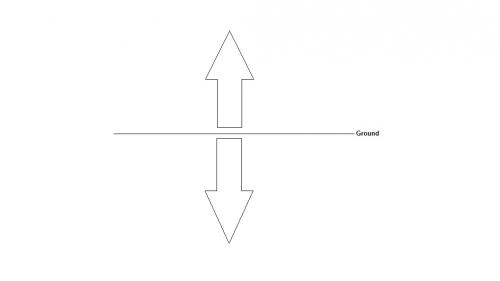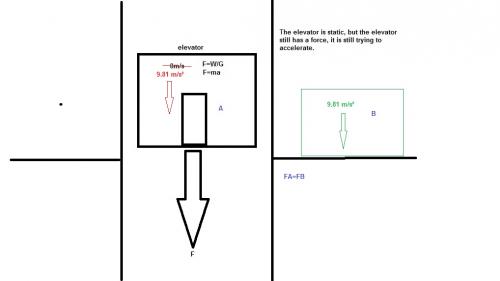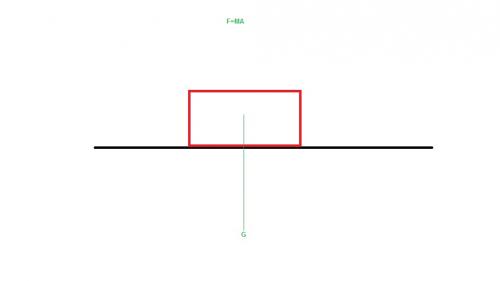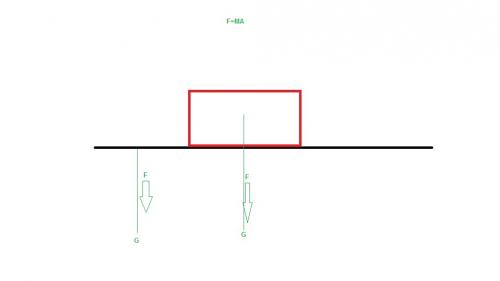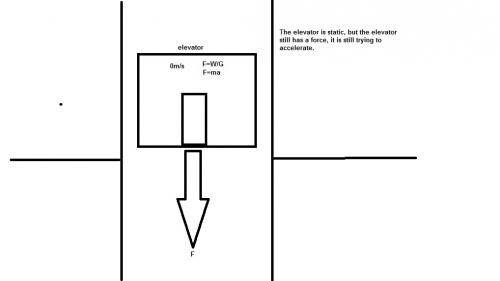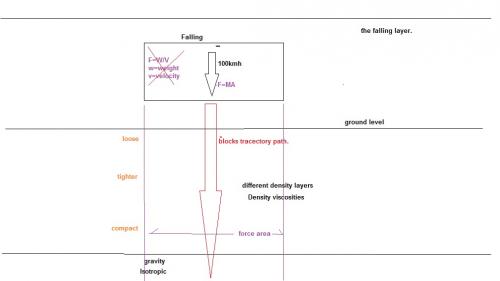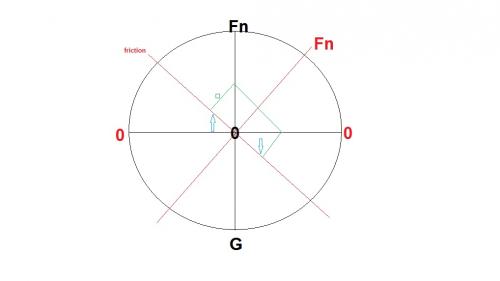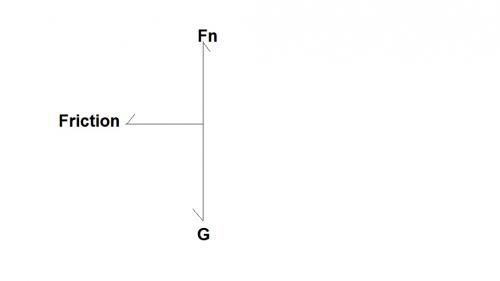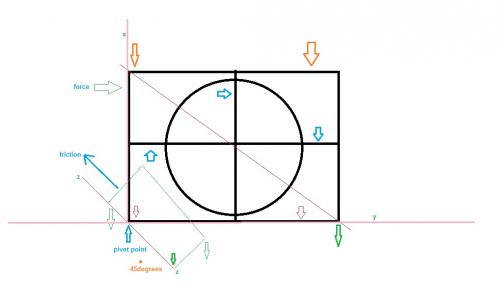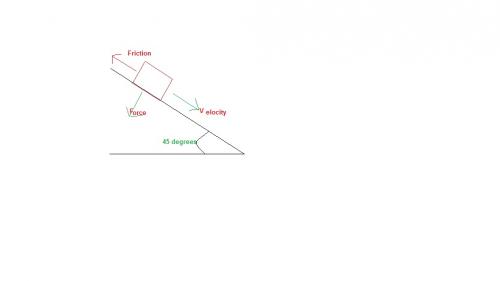

Relative
Senior Members-
Posts
685 -
Joined
-
Last visited
Content Type
Profiles
Forums
Events
Everything posted by Relative
-
There is no force observed, because there is no force from the ground. Mass Earth is just the absorbing volume of a density compared to the V and weight of a falling object. I thank you for your considerable patience and trying to explain, but I can not see any other force except gravity been involved, and have still no idea what force Fn is trying to represent. Now if you explained Fn has a weight shift on a molecular level of the object that was ''sliding'' down a hill, then I think I could understand that.
-
You can not see the contradiction in your own statement? Zero force exerted ''upwards''. zero has no force. F=MA, you are insinuating that the ground accelerates ''upwards''.
-
You are attracted to the core and the core is attracted to you , ''without the block there is no mass and thus no force produced.'' Incorrect, the ground has mass, the ground has force, equal to the force of the block even without the block, direction also equal to gravity direction. The ground is made of lots of blocks.
-
But the force of an object on a horizontal plane is not zero. The F is equal to falling speed, even though static, the amount of F is the amount of weight an object is, hence something's are heavy where others are light. You are trying to state that a static object has an equilibrium of force to the ground. 0 and 0. But no, the ground is 0, and the object continues its force always, hence subsidence. I am sorry for making a simple model into a complicated issue for me, I am still doing models, but I can not except this simple model if the logic does not work. Well actually, your arms and muscles would do the repelling, the opposite force, but the force is not strong enough to hold an heavy object. The ground pushes the same direction has the object. The object tries to push you through the ground. Both you, the object and the ground all are falling at the same force comparative to weight , comparative to gravity. All falling, isotropically ,centripetally.
-
I quote you ''It is theoretically impossible for the ground to push back. <-- and yet it does.'' so if the ground pushes back , it must have a repelling force to ''push'' has in my diagram. ''Until that point, however, the table will exert a force equal but opposite to the gravity force.'' like my diagram
-
You are saying that the ground is directed one way by gravity, centripetal, and also saying that the ground exerts a force the opposite direction to gravity, outwards, centrifugal, I would except this explanation if you admitted that the ground is been attracted to a center point, But also at the same time the ground of Earth, is been attracted to the Sun at the same time, and the core been repelled at the same time by the sun. Ok I take away the block, just the ground, you are saying this. Does not make sense unless above.
-
Yes that is what I am visualising, The force of a static object on the ground been equal to the speed it would fall at. I associate force with energy, something that has to be applied , exerted, I do not and can not see how the ground can exert a force, when it is surely just a matter of ''viscosities'', densities, and how much compacting there is of the matter underneath the object. Y is equal to Y X is equal to X But Y is not equal to X. Y been vertical axis, X been horizontal axis, and in context , compression. Meaning Y becomes more compact, where X expands because density is lost to surface motion/expansion, Force of A is equal to force of B? FA=FB? would that be a simple model? FA+FB=G? what is the science symbol for <and> FA and FB is equal to G
-
OK, I understand physical interactions of forces, but i still can not see why a static object would have any more than one force with no applied force. Where does the acceleration come from in this diagram? Unless you consider the Earth's rotation has movement, and then the force direction tag would depend on global positioning. If the ground was a spring, then yes, there would be a force extra. It is theoretically impossible for the ground to push back. Ok i will try another model example.
-
Hmmmm, your logic is of ''Data'' status. Yes every action has an opposite reaction. I do see that is what you are saying, but I miss the part where every action has an opposite reaction, having anything to do with every force has an opposite force, I paused after the last sentence above...........and think that is actually correct and all force has an opposite force?
-
Hmmm, ok, in the drawer instant, if a person applied force, there would be a resistance force, but if a person did not apply the force, there would be no resistance force, the resistance only occurring when we apply force. So the only force involved is surely the force of just us applying force, creating resistance force? You do not drown in water because you can not swim, you drown in water because you can not stop yourself falling.
-
I do see the concept you are trying to get me to understand, but an offset drawer, often made of wood, or sometimes metal, behave in accordance to heat, cold, humidity, swelling etc, I can not see been a force. I understand you are saying a force holds it jammed shut, but I see that has geometry mechanics, thermodynamics, elements. Not force, unless you are suggesting there is friction, but there is no friction until movement of the drawer. I suppose I could consider the weight of the set of drawers been a force , because of gravity.
-
I am unsure still sorry, example- I have a draw that is stuck, I decide to leverage it open using a flat ended screw driver, the force comes from me, transferred through the screw driver, forcing the draw to open. Where would the second force be in this example if it comes in pairs?
-
Yes I agree, creating a vice like grip on a block will hold it in place, although enough force , will still move the block and the vice. But in general talk on subject, yes. ''Two (equal) forces applied in opposition will hold it in place so it does not move.'' To make something that is truly stationary, the force would need to be isotropic. And if the block is on Earth, even though you have contained your block with vice like force, the block is still moving, because the planet is moving.
-
''Can you think of any other situation in which the block would not move sideways?'' Relative to the observer, sideways movement could also be achieved by moving the table. In no instant will the block not move sideways with enough applied force? Unless you are referring to Up and down, and the same, enough applied force in one direction, will result in the opposite direction for the block, Newtons third law. And heat rises, so does all forms of energy rise? And i have done a similar table diagram anyway Sorry for asking this moderators but it is important to some other homework. Buoyant gases rise because they thermodynamically charge faster .....?
-
The diagram above shows axis shift and level at the same time, 0 been level. Will a stationary object on a flat surface move , no, unless there is acting force. Will a stationary object fall to floor if on a flat table, no, because the density of the table prevents it from falling. Tilt the table, the weight of the object is shifted. Ok ty for the help, I will try to work it out later when I completely get my head around what you are asking. I already understand F=MA, I still do not understand what the normal force suppose to be, or is created by. But I will give it ago later tyvm.
-
You want me to angle the gravity axis , in accordance to the slope, I do know what you saying, and understand what you are saying, but the gravity vector would always point down regardless of angle. Changing the angle of the slope only changes what you call the Fn, not the direction of gravity. ''Newton's Third Law: to ever action there is an equal and opposite reaction. Do you still wish to maintain it is not true?'' Well if science thinks the ground pushes back then yes. But another story, I got stick too these basic physics models,
-
There would be no point in me just re drawing your diagram and copying it. You want me to put the upwards arrow for normal force representation, Fn, but I am still failing to see where the normal force comes from, you say the ground, how does the ground emit any sort of force? Are you saying the object pushes on the surface and the surface pushes back? Like this? but obvious friction axis angled.
-
I do not think I understand, are you asking what force makes the block not slide and be static? less weight or more friction by surface material!. The block always wants to fall because of gravity, the force, is the weight, unless you consider the surface friction to be a force. I am sorry I can not see any other force involved.
-
''Everyday experience tells us that a slope at 90 degrees would not result in the block staying on the slope. So there must be some relationship between the direction of the force keeping the block on the slope and the angle of the slope. '' I do not understand, the only force I can see is vertically down. Weight of object, making that force. Friction holding the object from sliding, <resistance>, and the direction and the velocity created by the angle of descent and surface friction. Do I see that correctly? all the arrows represent force direction that the pivot point of contact makes. There is two boxes in this diagram, the smaller green one is sliding, the larger is tumbling. What am I missing? why does it need anything else? i should of asked what are we trying to work out?
-
Thank you for giving me the warning and giving me chance to continue with the thread has long is it is on track to models. Ok, I will only talk current models, and avoid all other subject matter, although it was my homework, I will now do the homework you provide. I will look back now in the thread to find the model you suggested to look at. I am sorry for going off in my own little world. ''A square mass sliding on a inclined plane is a good exercise:'' Would the first parameters be correct in this diagram? And my meaning of parameter is this definition - ''a numerical or other measurable factor forming one of a set that defines a system or sets the conditions of its operation.''
-
I am sorry , some one agreed with my earlier model has been crude but describing vague , so I improved the model and added some simple formula. With formula explanation , of the values. My model explains a simple equilibrium between two values and each action. X been repelled by Y and Y been repelled by X , Z is attracted to both X and Y, X the nearer to Z having stronger force on Z. Z also been attracted to Y, and Y attracted to Z. The distance between the objects , deemed by volume of x,y,z, and their energies contained. I am confused, because I try to improve on the maths, using formulas, I am sorry from my perspective view I thought it was easy to understand. How is my model not a model when I have explained the parameters to the diagram? Change it to magnetic interactions if you like
-
If I was using this model for gravity, x=Earth's core, Y=Sun, Z=space dust/matter If I was using this model for perpetual motion, X=positive polarity, Y=positive polarity, Z=negative polarity Like my earlier diagram model. I am 99% logically sure I could make a simple device, that would create energy literally out of fresh air using this model and the concept and idea that goes with it. Would something with no applied energy, e.g. batteries etc, that continually vibrates be classed has perpetual motion?
- 149 replies
-
-1
-
No batteries etc either I am seriously learning, I am discussing models, and getting to grips with what a model is. And I should of said , what do you actually mean by dimensions? And I think from my model, I have an idea now, and can build a device that uses and creates its own natural energy and will vibrate , it may even move on a low friction surface like ice. Does the Earth vibrate? ''We use letters to represent variables. Those variables have to have dimensions. They cannot have multiple dimensions.'' Arrr, I think I understand you now, like radius , diameter etc?
-
should I add energy somewhere to it and force maybe OK I apologise, I am trying not, to let my model homework, look like i am creating theories etc, So putting vague formulas without the correct descriptive content. ''1. There is no such thing as Newton's third law of opposites attract. Newton;s Third Law of Motion asserts that to every action there is an equal and opposite reaction. That is wholly different from what you are saying. You have previously denied Newton's Third Law, declaring multiple times that the ground does not push back when we are standing on it. Have you changed your mind?'' I have not changed my mind about the ground pushing back, everything is always falling in my mind. ''2. You say Y is equal to X, but opposite to Z. In what way? Is one a Republican, the other a Democrat?'' Negative attracts positive? polarities, energies ''3. What are the dimensions of y and x? I do not mean what size are they. I mean are you talking kilograms, or metres, or gm/cc, or.......?'' The volume, the weight, the density, the mass, the strength of energy. ''4. What do you think you are representing by the expression yzx?'' Perpetual motion - an equilibrium of forces that creates movement. Pushing and pulling at the same time. And representing y=kx but i needed a third parameter. ''5. What the ***** is d? Lower case d, is not the same as upper case D. Apparently you think they are. So, I'll pretend they are in this instance. How can you claim that a distance, whose units are length is equal to the result of multiplying three undefined variables together?'' And no not multiplying, but the combination of the results of affect of the opposite reactions, equal actions. Would science accept an object that vibrates with no added external energy, to be perpetual motion?
- 149 replies
-
-2
-
Hmm ok thx, The circles on the left represent 1 object of two different physical bodies , an outer body Z that is attracted to an inner body X. Newtons third law of opposites attract. The right hand Physical body is of one object Y that is equal to X but opposite of Z. z≠yx D is distance So D is directly proportional to the affects of yzx? d=yzx

